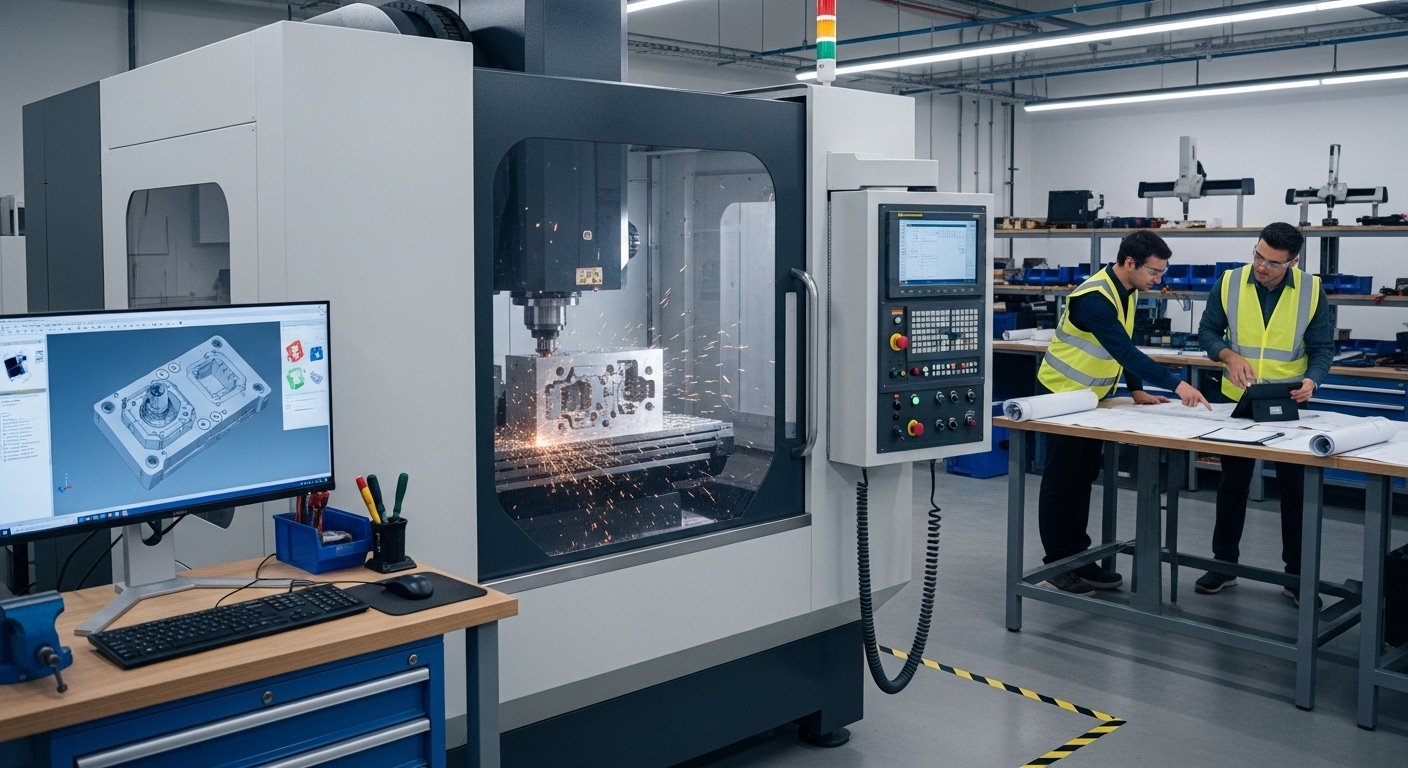In today’s fast-paced manufacturing world, bringing a product from concept to market quickly can make all the difference. That’s where prototype tooling services come in. These specialized services allow businesses to create high-quality prototypes using temporary molds, helping validate designs, test functionality, and iterate without the high costs of full production tooling. Whether you’re in automotive, aerospace, medical devices, or consumer products, understanding prototype tooling services is key to de-risking your development process and accelerating time-to-market.
If you’ve ever wondered how companies produce small batches of parts that look and feel like the real thing, prototype tooling is often the answer. It bridges the gap between initial ideas and mass production, using techniques like rapid injection molding to deliver results in days rather than months. In this guide, we’ll dive into what prototype tooling services entail, their benefits, and how to leverage them for your next project.
What is Prototype Tooling?
Prototype tooling refers to the creation of temporary or “soft” molds used to produce a limited number of parts for testing and validation. Unlike production tooling, which is built for high-volume runs and longevity, prototype tooling focuses on speed and cost-efficiency. It’s ideal for early-stage development where you need to check fit, form, and function before committing to expensive steel molds.
At its core, prototype tooling services involve designing and fabricating molds from materials like aluminum, pre-hardened steel, or even 3D-printed resins. These molds can handle anywhere from a few dozen to a few thousand shots, depending on the material and complexity. For instance, aluminum molds are popular because they’re easier to machine and modify, reducing lead times significantly.
Think about a startup developing a new medical device. They might use prototype tooling to create 100 units for clinical trials, spotting issues like material shrinkage or part warping early on. This approach not only saves money but also ensures the final product meets stringent standards.
Benefits of Prototype Tooling Services
Why opt for prototype tooling services over other methods? The advantages are clear and multifaceted.
First, there’s the speed factor. Traditional tooling can take weeks or months, but prototype services often deliver molds in as little as one week. This rapid turnaround allows for quick iterations—make a part, test it, tweak the design, and repeat. In competitive industries like automotive, where electric vehicle components evolve rapidly, this agility is invaluable.
Cost savings are another major perk. Prototype molds are cheaper to produce because they use softer materials and simpler designs. You avoid the hefty upfront investment of production tooling while still getting parts in production-grade plastics or rubbers. This de-risks your project; if changes are needed, you’re not scrapping a $100,000 steel mold.
Moreover, prototype tooling enables realistic testing. Parts made from these molds mimic the properties of final products, including strength, texture, and color. This is crucial for functional validation, such as ensuring an aerospace part withstands extreme temperatures or an automotive trim fits perfectly.
Finally, it supports low-volume production runs, perfect for market testing. Produce a pilot batch, gather feedback from potential customers, and refine before scaling up. Companies like those in consumer electronics use this to gauge interest without overcommitting resources.
Types of Prototype Tooling
Prototype tooling isn’t one-size-fits-all. Services typically offer several types to suit different needs.
1. Direct Rapid Tooling: This involves creating the mold directly from CAD data using CNC machining or 3D printing. For example, aluminum or soft steel molds are machined for precision and can produce thousands of parts. 3D-printed molds, often in metal or high-temp plastics, excel at complex geometries but may have shorter lifespans.
2. Indirect Rapid Tooling: Here, a master model (like a 3D-printed prototype) is used to create the mold via casting or thermoforming. Silicone rubber molds are common for casting urethane parts, offering flexibility for undercuts and quick setup. Composite molds provide durability for slightly higher volumes.
3. Soft Tooling vs. Rapid Tooling: Soft tooling uses easily machinable materials for low-cost, low-volume runs. Rapid tooling emphasizes speed, often incorporating additive manufacturing to cut lead times. Many services blend these for optimal results.
Choosing the right type depends on your part’s complexity, material requirements, and timeline. For intricate designs, direct methods shine; for simpler shapes, indirect can be more economical.
Prototype Tooling vs. Production Tooling
It’s easy to confuse prototype and production tooling, but the differences are stark.
Prototype tooling is designed for short runs—typically 100 to 5,000 parts—with a focus on flexibility. Materials like aluminum allow easy modifications, but the molds wear out faster. Lead times are short (7-14 days), and costs are lower, making it ideal for validation.
Production tooling, on the other hand, uses hardened steel for durability, handling millions of cycles. It’s more expensive and time-consuming to build (4-12 weeks) but ensures consistency in high-volume manufacturing. Think of it as the marathon runner compared to prototype tooling’s sprinter.
Many businesses start with prototype services and transition seamlessly to production, using the same provider to maintain quality. This hybrid approach minimizes risks and streamlines the supply chain.
Methods and Materials in Prototype Tooling Services
Prototype tooling services employ advanced methods to bring designs to life.
CNC machining is a staple, carving molds from blocks of aluminum or steel with high precision. Electrical Discharge Machining (EDM) handles intricate details that CNC can’t reach. 3D printing adds layers for rapid mold creation, especially useful for prototypes with internal channels.
Materials vary by application. Aluminum is lightweight and cost-effective for most plastic injection molding. Pre-hardened steel offers better wear resistance for rubber parts. For specialty needs, like high-heat applications inaerospace, exotic alloys or composites come into play.
Injection molding is the most common process, but services may also include blow molding, compression molding, or vacuum forming. The goal? Produce parts that accurately represent the final product, from ABS plastics to silicone rubbers.
The Prototype Tooling Process: Step-by-Step
Wondering how prototype tooling services work in practice? Here’s a straightforward breakdown.
- Initial Design and Consultation: Submit your CAD model. Engineers review it for manufacturability, suggesting tweaks to avoid issues like thin walls or sharp corners.
- Material and Method Selection: Based on your needs, choose the tooling type—aluminum for speed, steel for durability. Discuss tolerances, surface finishes, and part volumes.
- Mold Fabrication: Using CNC, EDM, or 3D printing, the mold is created. This step typically takes 5-10 days.
- Prototyping and Testing: Inject material into the mold to produce parts. Test for fit, function, and flaws. Iterate as needed—molds can often be modified quickly.
- Validation and Refinement: Run quality checks, perhaps including CT scans or stress tests. Refine the design before moving to production.
- Transition to Scale: If successful, export the tooling knowledge to production molds or continue with low-volume runs.
This process ensures efficiency, with many providers offering on-site tryouts and logistics support.
Applications of Prototype Tooling Across Industries
Prototype tooling services aren’t limited to one sector—they’re versatile powerhouses.
In automotive, they’re used for interior trims, HVAC components, and EV battery housings. Aerospace relies on them for lightweight parts that endure harsh conditions. Medical devices benefit from biocompatible prototypes for FDA approvals.
Consumer products, like electronics casings or packaging, use tooling for aesthetic and functional testing. Even agriculture employs it for durable equipment parts.
For example, a heavy equipment supplier might prototype large RIM-molded components with mirror polishes, ensuring they meet field demands.
(Suggested internal link: Explore our guide on rapid prototyping for more on additive manufacturing techniques.)
How to Choose the Right Prototype Tooling Service Provider
Selecting a provider can feel overwhelming, but focus on these criteria.
Look for expertise in your industry—do they have case studies in automotive or medical? Check technology: Advanced CNC, EDM, and 3D printing are musts.
Turnaround times matter; aim for 1-2 weeks for molds. Ensure they offer comprehensive support, from design feedback to quality reports.
Cost-effectiveness is key, but don’t sacrifice quality. Reliable suppliers guarantee molds run perfectly, even if exported.
Finally, read testimonials. Happy clients signal a partner who delivers on promises.
(Suggested internal link: Learn about custom injection molding in our related article.)
Conclusion
Prototype tooling services are a game-changer for modern manufacturing, offering speed, savings, and superior validation. By integrating them into your workflow, you can iterate faster, reduce risks, and launch better products. Whether you’re a startup or an established firm, partnering with the right service can propel your ideas forward.
Ready to get started? Assess your project needs and reach out to a trusted provider today. The future of your product might just depend on that first prototype mold.
Explore Mor Topic: What is OCAS
FAQ
What is the typical lead time for prototype tooling services?
Lead times vary but often range from 7 to 14 days for mold creation, depending on complexity and material. Rapid options can deliver in as little as 5 days.
How much do prototype tooling services cost?
Costs start at a few thousand dollars for simple aluminum molds, scaling up based on size and features. They’re significantly cheaper than production tooling, making them accessible for low-volume needs.
Can prototype tooling produce parts in production-grade materials?
Yes, absolutely. Services use the same plastics, rubbers, and resins as final production, ensuring accurate testing of properties like strength and flexibility.
What’s the difference between prototype tooling and 3D printing?
Prototype tooling excels at creating multiple parts quickly with injection molding realism, while 3D printing is better for single, complex prototypes without molds. Tooling bridges to production more seamlessly.

